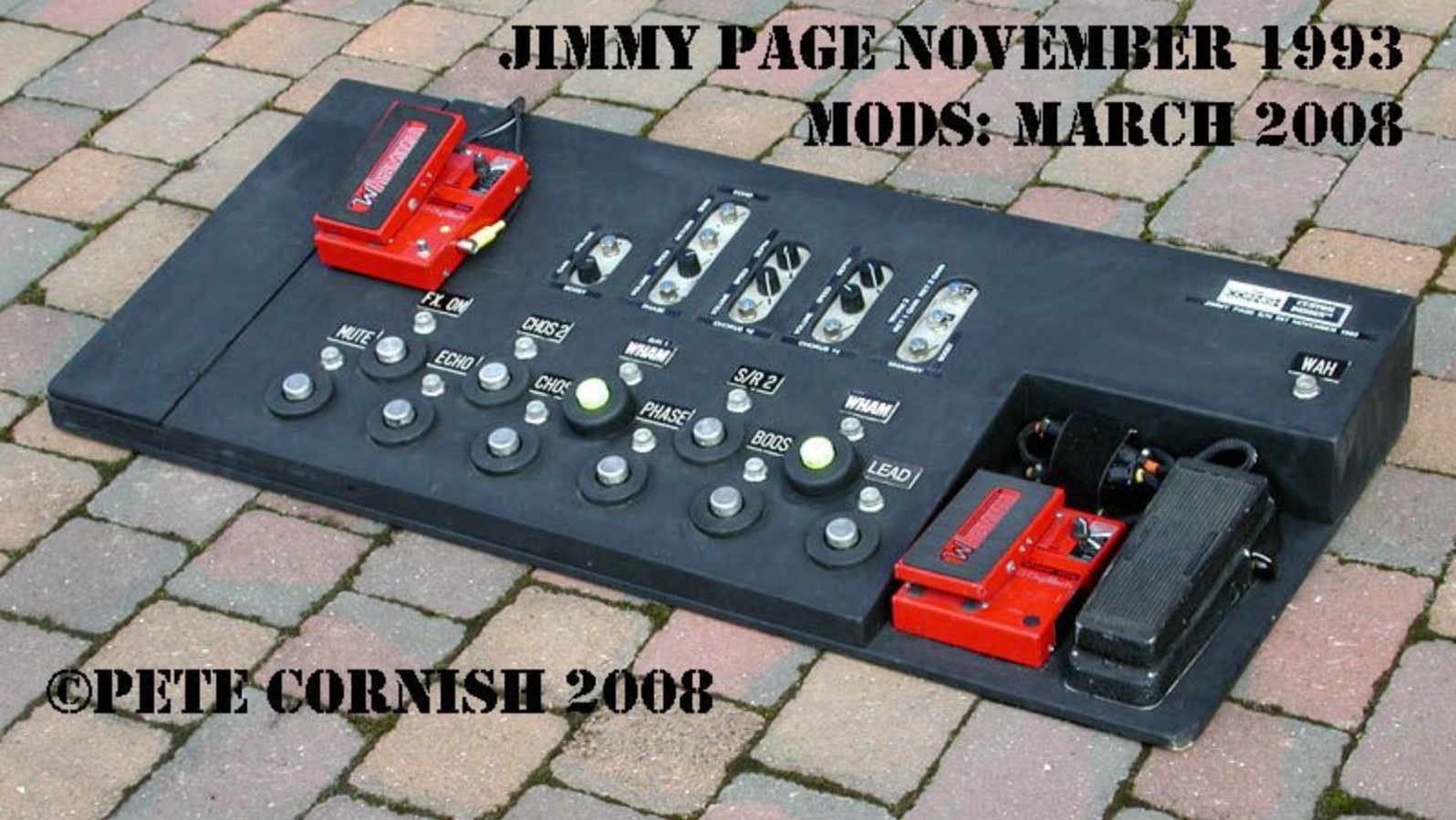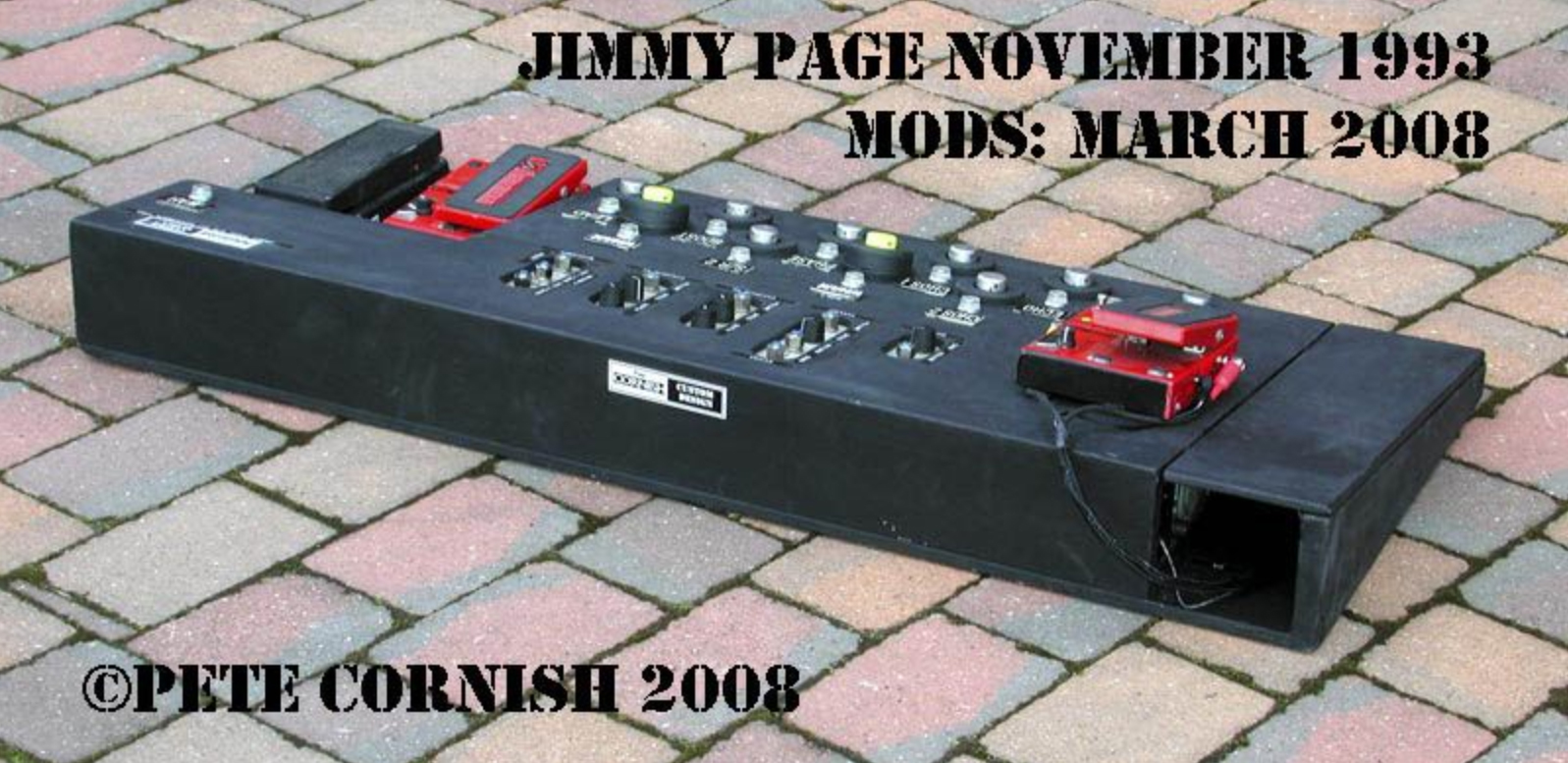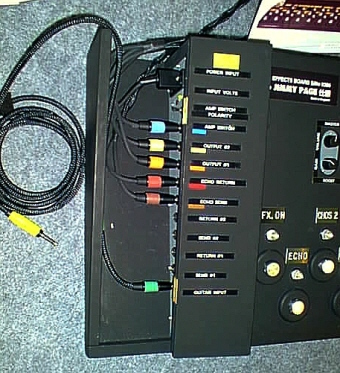gangstafacka
Registrierter Benutzer
- Zuletzt hier
- 31.12.23
- Registriert
- 21.02.04
- Beiträge
- 686
- Kekse
- 2.050
Hi Leute,
der Titel sagt schon genau, worum's hier geht. Darf ich vorstellen ? Das ist das Effektboard, was Jimmy Page bis zum heutigen Tag benutzt:
Problem: In Sachen Effekte bin ich blutiger Anfänger und blick' kaum was, würde es aber sehr gerne !
Und darum wend' ich mich an euch; lasst uns mal gemeinsam aufdröseln, wat der ganze Kram da soll.
Wie ihr seht, habe ich schon die ersten beiden Punkte um Informationen ergänzt, die für Anfänger begreifbar machen,
was die jeweiligen Punkte sein sollen und warum sie ausgerechnet da sind.
Aber schon beim nächsten Punkt gerat' ich irgendwie in's Stocken.
Aaaalso, vom Boost/Line Driver ausgehend geht das Signal in's Pedalboard; und womit wird beides verbunden ?
Mit einem "Signal Cable Loom (Loom includes Amp Feeds and Remote Mute Control)"; Fragen:
Wat ist das ? Das ist ja offensichtlich nicht nur ein normales Gitarren-Kabel; dieses "Loom" macht mir die Sache
unbegreifbar. Was ist ein "Amp Feed" ? Wozu ist das gut ? Warum ist das da und nicht woanders ? Und steckt das im Kabel drin?! ''
''
Was ist ein "Remote Mute Control" ? Wozu ist das gut ? Warum ist das da und nicht woanders ? Und steckt das im Kabel drin?! ''
''
Ich hab' schon eine Suchmaschine bedient; die Ergebnisse dazu waren unbefriedigend. Ich hab' auch keine aufschlussreichen Bilder dazu
finden können.
Nach Möglichkeit werd' ich Erkenntnisse im Eingangsbeitrag nachtragen...
der Titel sagt schon genau, worum's hier geht. Darf ich vorstellen ? Das ist das Effektboard, was Jimmy Page bis zum heutigen Tag benutzt:
JIMMY PAGE'S GUITAR/EFFECTS/AMPS FLOOR SYSTEM
After extensive testing and comparisons of various effects pedals and amplifiers by Jimmy and his technician we were asked to build an effects system that would operate with equal efficiency in every country in the world and incorporate all Jimmy's chosen effects and route the signal to several amplifiers.
Most of the effects had so called "true bypass" footswitches and we decided to investigate whether we could use this system with the entire collection of effects and amps as so many manufacturers offer the "true bypass" as the ultimate type of switching.
Our findings were that the "true bypass" did NOT create unified signal level or tone from the guitar for the following reason:
Take for instance a 5m guitar cable linked to six pedals, each linked by a 1m cable, and then on to the amp by say a 15m cable. If all pedals have "true bypass", and are off, then the total cable length hanging on the guitar output will be 25m. This will cause a huge loss of tone and signal level particularly if the guitar is a vintage type with low output. The amp volume is then turned up and the treble control increased to compensate for the losses. The inherent background noise now increases by the amount of the gain and treble increase and is usually, in my experience, too bad for serious work. If one of the pedals is now switched on, then it's high input impedance (and usually low output impedance) will buffer the output cables from the guitar; the signal level and treble content will rise due to the removal of some of the load on the pickups (i.e. 6m instead of 25m of cable). If that pedal was for example a chorus or delay, devices which are usually unity gain, then the overall signal level and tone will vary each time an effect is added...not a very good idea.
The "Pete Cornish System", which we devised in the early 70's, is to feed the guitar into a fixed high impedance load, which is identical to the amp input, and then distribute the signal to the various effects and amps by low impedance buffered feeds. This gives a constant signal level and tonal characteristics from the guitar, which do not change at all when effects are added. The proof that this works are in the recordings of our clients: Roxy Music; The Police; Queen; Pink Floyd; Bryan Adams; Lou Reed; Dire Straits; Paul McCartney; Sting; Judas Priest; Black Sabbath....
For Jimmy's stage system, we fitted additional high impedance pre-amps between each effect to further isolate each one from the next in line. We also provided two send/return circuits so that new effects could be added at a later date and another send/return to Jimmy's Echoplex. The four isolated outputs to the stage amplifiers each had a line driver fitted to overcome the very long across-stage cables (total length 64m).
To ensure that the sound of the guitar and effects would remain constant at each venue across the world we designed "super regulated" dc power supplies to suit both the effects and the audio frequency pre-amps. Each effect and pre-amp had it's own isolated dc feed which we know helps to prevent cross-leakage of effect signals: for example upper harmonic distortion products can leak into clean chorus circuits through a common power supply if this precaution is not taken.
Jimmy was very pleased with his "Pete Cornish Guitar/Effects/Amps System" and it has proved most reliable and convenient to set up, as all the effects and routing are permanently in the correct
order and it is so simple to "just plug in and play..."
GUITAR SYSTEM S/No: 257
DESIGNED AND BUILT BY PETE AND LYNDA CORNISH
OCTOBER 1993



Updates
1995 - Guitar Selector/Line Driver
1998 - AC Distribution Unit
2002 - AC Power Wah
2007 - 4 Channel Amp routing Loom/Junction Box
2007 - Remote Mute/Echoplex Routing Loom
Signal Routing:
Guitar ->
Guitars connected to Pete Cornish Input Selector – so a box enabling one to connect more than just one instrument to the very same rack and switching between the instruments –
…and Line Driver (off stage) – a box boosting the input signal without changing frequency response (so, causes more gain, but no changed sound, no distortion, no overdrive, no whatsoever; just louder, that’s it; one can use it to such an extent that your sound becomes a fundamental lead sound without any change in frequency response; just an example: https://www.thomann.de/de/mxr_mc401.htm?sid=1d5773bd112447dd8be0983e381d69fa ) – via Pete Cornish HD Guitar Cables
Selected Guitar Signal to Effects / Amps Pedalboard via Pete Cornish Custom Signal Cable Loom (Loom includes Amp Feeds and Remote Mute Control)
Pedalboard Input - Unity Gain
Emergency Automatic Mechanical Bypass to Output #1 in case of Power Failure
Send / Return to Spare FX #1 with Bypass Switch
Roger Meyer Voodoo Fuzz - Removed in January 1996 - Replaced by Amp Lead switch for 2 off Fender Tone Master
MXR Phase 90 with Bypass Switch
Yamaha CH-10Mk II Chorus with Bypass Switch
Send / Return to Spare FX #2 with Bypass Switch
Boss CE-2 Chorus with Bypass Switch
Jen Cry-Baby Wah with Bypass Switch
Digitec WH-1 Whammy + Pete Cornish Linear Boost 0/+20dB with Bypass Switch
Send / Return to Echoplex EP3 (modified by Pete Cornish) with Adjustable Gain and Bypass Switch
Linear Boost all Outputs 0/+20dB with Bypass Switch
Master Volume
Local and Remote Mute All Outputs
3 off Outputs to Amps - Output #4 added January 1995
115V Output to Echoplex
-> amp
Problem: In Sachen Effekte bin ich blutiger Anfänger und blick' kaum was, würde es aber sehr gerne !
Und darum wend' ich mich an euch; lasst uns mal gemeinsam aufdröseln, wat der ganze Kram da soll.
Wie ihr seht, habe ich schon die ersten beiden Punkte um Informationen ergänzt, die für Anfänger begreifbar machen,
was die jeweiligen Punkte sein sollen und warum sie ausgerechnet da sind.
Aber schon beim nächsten Punkt gerat' ich irgendwie in's Stocken.
Aaaalso, vom Boost/Line Driver ausgehend geht das Signal in's Pedalboard; und womit wird beides verbunden ?
Mit einem "Signal Cable Loom (Loom includes Amp Feeds and Remote Mute Control)"; Fragen:
Wat ist das ? Das ist ja offensichtlich nicht nur ein normales Gitarren-Kabel; dieses "Loom" macht mir die Sache
unbegreifbar. Was ist ein "Amp Feed" ? Wozu ist das gut ? Warum ist das da und nicht woanders ? Und steckt das im Kabel drin?!
Was ist ein "Remote Mute Control" ? Wozu ist das gut ? Warum ist das da und nicht woanders ? Und steckt das im Kabel drin?!
Ich hab' schon eine Suchmaschine bedient; die Ergebnisse dazu waren unbefriedigend. Ich hab' auch keine aufschlussreichen Bilder dazu
finden können.
Nach Möglichkeit werd' ich Erkenntnisse im Eingangsbeitrag nachtragen...
- Eigenschaft


 , wenn dann der Sänger /Bassist über das teil stolpert
, wenn dann der Sänger /Bassist über das teil stolpert 